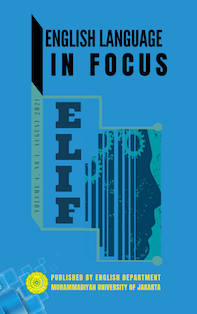Tongue Twister Rap: Bringing Joy to EFL Pronunciation Class
DOI:
https://doi.org/10.24853/elif.4.1.25-32Keywords:
Tongue Twister Rap, Pronunciation Class,Abstract
This study aims to determine the new combination of tongue twisters with rap music applied in the pronunciation class. The data in this study used a descriptive qualitative approach. The primary data in this study were interviews, documentation, and interview results, which contained pronunciation-learning activities using, rap music. The result of the research is that the application of tongue twister rap in the pronunciation class has several steps are the first is to explain the pronunciation learning material first. The second step is to write a tongue twister on the board and continue by explaining how to read and pronounce it. Then teacher drills the students back slowly until quickly, combining the tongue twister with rap music several times, and guiding the students to practice tongue twister rap as well as making battle rap. The benefits of this application are making pronunciation and speaking more fluent, making pronunciation learning interesting and fun so that it makes students easier to understand learning material, making pronunciation clearer and more correct. The weakness of the application of tongue twister rap is that tongue twister rap can break the concentration of other class students because students are very interested in learning pronunciation due to learning with tongue twister rap. The conclusion is that tongue twister rap is an enjoyable learning technique in pronunciation class. This study suggests continuing research to get information about the effectiveness of tongue twister rap in pronunciation class and find various other techniques in teaching pronunciation.References
Adi, P. (2011). Representation of Moral Values in Rap Song Lyrics. Thesis. Veteran National Development University.
Amar, L. N., Mu’in, F., & Rusmanayanti, A. (2019). Students’ Perceptions on The Use of Tongue Twisters in Learning Pronunciation. Lingua Educatia, 1(2), 73-92. Retrieved from http://103.81.100.242/index.php/gej/article/view/293
Asilfa, T., Rahman, M., & Rozal, E. (2019). The Effect of Tongue Twister Technique on Students’ Pronunciation Ability (Doctoral Dissertation, UIN Sulthan Thaha Saifuddin Jambi). Retrieved from http://repository.uinjambi.ac.id/id/eprint/2549
Bakar, Z. A., & Abdullah, M. R. (2015). Importance of Correct Pronunciation in Spoken English: Dimension of Second Language Learners’ Perspective. Pertanika Journal of Social Sciences and Humanities, 23(8), 143-158. Retrieved from http://www.pertanika.upm.edu.my/
Conde, C. D. A., García, A. E. V., Vásquez, C. W. P., & Gavilánez, M. P. G. (2017). Micro–curricular Planning Based on Tongue Twisters as a Pronunciation Strategy. Quito-Ecuador: EDICIEM. Retrieved from http://www.dspace.uce.edu.ec/handle/25000/14020
Hutasoit, R., & Tambunan, B. (2018). The Effect of Ice Breaking Technique in Teaching Speaking at the Tenth Grade Students of SMK Dharma Bhakti Siborongborong in Academic Year 2018/2019. International Journal of English Literature and Social Sciences, 3(5), 264455. https://dx.doi.org/10.22161/ijels.3.5.2
Inawati, I. (2016). The Pragmatics of Greetings Reflected in the Textbooks for Teaching English as a Foreign Language in Indonesia. Ahmad Dahlan Journal of English Studies (ADJES), 3(2), 1-10. http://dx.doi.org/10.26555/adjes.v3i2.4984
Kelly, G. (2000). How to teach pronunciation. Person Education Limited.
Miranda, D. (2013). The Role of Music in Adolescent Development: Much More than the Same Old Song. International Journal of Adolescence and Youth, 18(1), 5-22. https://doi.org/10.1080/02673843.2011.650182
Mu’in, F., Amrina, R., & Amelia, R. (2017). Tongue Twister, Students’ Pronunciation Ability, and Learning Styles. Arab World English Journal (AWEJ), 8(4), 365-383. http://dx.doi.org/10.2139/ssrn.3094542
Pourhosein-Gilakjani, A., Namaziandost, E., & Ziafar, M. (2020). A Survey Study of Factors Influencing Iranian EFL Learners’ English Pronunciation Learning. International Journal of Research in English Education, 5(2), 103-123. http://dx.doi.org/10.29252/ijree.5.2.103
Putri, Y. A., Sada, C., & Riyanti, D. (2018). Improving Students' Pronunciation by Using Tongue Twister Technique. Jurnal Pendidikan dan Pembelajaran Khatulistiwa, 7(11), 1-9. Retrieved from https://jurnal.untan.ac.id/index.php/jpdpb/article/view/29732/75676579231
Rahmayanti, P., Saraswati, P. A., & Bhuana, G. P. (2019). The Use of Ice Breaker to Improve Students’ motivation in Learning English at The Tenth Grade Students Of SMK YPKKP. Project (Professional Journal of English Education), 2(5), 594-600. http://dx.doi.org/10.22460/project.v2i5.p594-600
Sitoresmi, U. (2016, January). Tongue twisters in pronunciation class. In Proceeding of International Conference on Teacher Training and Education (Vol. 1, No. 1). Retrieved from https://jurnal.fkip.uns.ac.id/index.php/ictte/article/view/7673/5514
Turumi, Y. L. (2016). Using Tongue Twister to Improve the Pronunciation of Grade VIII Students. e-Journal of ELTS (English Language Teaching Society), 4(2). Retrieved from http://jurnal.untad.ac.id/jurnal/index.php/ELTS/article/view/6019
Uhlig, S., Dimitriadis, T., Hakvoort, L., & Scherder, E. (2017). Rap and Singing are Used by music Therapists to Enhance Emotional Self-Regulation of Youth: Results of a Survey of Music Therapists in the Netherlands. The Arts in Psychotherapy, 53, 44-54. https://doi.org/10.1016/j.aip.2016.12.001
Downloads
Published
Issue
Section
License
Authors who publish with this journal agree to the following terms:
- Authors retain copyright and grant the journal right of first publication with the work simultaneously licensed under a Creative Commons Attribution License that allows others to share the work with an acknowledgment of the work's authorship and initial publication in this journal.
- Authors can enter into separate, additional contractual arrangements for the non-exclusive distribution of the journal's published version of the work (e.g., post it to an institutional repository or publish it in a book), with an acknowledgment of its initial publication in this journal.
- Authors are permitted and encouraged to post their work online (e.g., in institutional repositories or on their website) before and during the submission process, as it can lead to productive exchanges, as well as earlier and greater citation of published work (See The Effect of Open Access).

